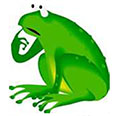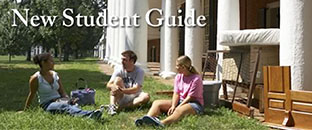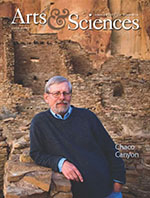Welcome to the Arts & Sciences Style Guide. Using a style guide helps eliminate inconsistencies in spelling, punctuation and grammar. This page contains style guidelines specific to Arts & Sciences and address some frequently asked style questions. Arts & Sciences editorial style is based primarily on the Associated Press Stylebook, which is used by most American newspapers as well as many college and university communications offices. It works well for web audiences because, like newspaper readers, they tend to scan the text rather than read every word.
For information on matters of style unique to UVA that are not covered on this page, see https://alumni.virginia.edu/university-of-virginia-style-guide/.
For official University of Virginia brand guidelines and assets, please see brand.virginia.edu.
General
- The South Lawn Project (not SLP)
- Official name: College and Graduate School of Arts & Sciences (second reference: the College)
- Arts & Sciences (not Arts and Sciences)
- UVA (no spaces) for University of Virginia. (Not “U.Va.”)
- When listing major and graduation year: James Johnson (English '06) or James Johnson (Ph.D. English ’06)
- first-year, second-year, third-year, fourth-year student (not freshman, sophomore, junior, senior)
- Names of months are spelled out in text when NOT accompanied by a specific date: She graduated in May 2005. The following months are abbreviated when accompanied by a date: Jan., Feb., Aug., Sept., Oct., Nov. and Dec.: The fall semester begins on Aug. 15.
- Time of day: 9 a.m., 7:45 a.m., 2:30 p.m.
- advisor (not adviser)
- professor (not prof.)
- website (not web site, Website, Web site)
- webpage (not web page, Web page, Webpage)
- African American; Native American; Asian American (NO hyphen when used as a modifier, per 2019 change in AP Stylebook rule on dual heritage references: Native American heritage; EXCEPTION: Carter G. Woodson Institute for African-American and African Studies)
- Do not use a comma before Jr., Sr., II, III, etc. For example: James Johnson Jr.; James Johnson III.
- On the web, URLs should always include the http:// prefix: For example: To obtain more information; visit the University’s website at http://www.virginia.edu. In print, you can drop the http://www prefix. For example: To obtain more information; visit the University’s website at
- virginia.edu.
- Use percent (not per cent; or %): The professor noted that 7 percent of his students had failed the test.
- No double spaces between sentences
- "internet" is not capitalized
Headers
- In headers, capitalize the first letter of every noun: For example: Completion of a Major
- If the header is a complete sentence, use down-style capitalization, where only the first word and any proper nouns are capitalized. For example: The registration deadline is Dec. 1.
Punctuation
- Commas: Use commas to separate elements in a series, but do not put a comma before the conjunction in most simple series: The flag is red, white and blue. He would nominate Tom, Dick, Harry or Jeannette. She goes to school, plays league soccer and takes private dance lessons.
Include a final comma in a simple series if omitting it could make the meaning unclear. The governor convened his most trusted advisers, economist Olivia Schneider and polling expert Carlton Torres. (If Schneider and Torres are his most trusted advisers, don’t use the final comma.) The governor convened his most trusted advisers, economist Olivia Schneider, and polling expert Carlton Torres. (If the governor is convening unidentified advisers plus Schneider and Torres, the final comma is needed.)
Put a comma before the concluding conjunction in a series if an integral element of the series requires a conjunction: I had orange juice, toast, and ham and eggs for breakfast.
Use a comma also before the concluding conjunction in a complex series of phrases: The main points to consider are whether the athletes are skillful enough to compete, whether they have the stamina to endure the training, and whether they have the proper mental attitude.
- Compound modifiers: Do use a hyphen if it’s needed to make the meaning clear and avoid unintended meanings: small-business owner, better-qualified candidate, little-known song, French-speaking people, free-thinking philosophy, loose-knit group, low-income workers, never-published guidance, self-driving car, bases-loaded triple, one-way street (Think of the different possible meanings or confusion if the hyphen is removed in each of those examples.)
Other two-word terms, particularly those used as nouns, have evolved to be commonly recognized as, in effect, one word. No hyphen is needed when such terms are used as modifiers if the meaning is clear and unambiguous without the hyphen. Examples include third grade teacher, chocolate chip cookie, special effects embellishment, climate change report, public land management, real estate transaction, emergency room visit, cat food bowl, parking lot entrance, national security briefing, computer software maker.
Hyphenate well- combinations before a noun, but not after: a well-known judge, but the judge is well known.
Generally, also use a hyphen in modifiers of three or more words: a know-it-all attitude, black-and-white photography, a sink-or-swim moment, a win-at-all-costs approach. Consider carefully, though, before deciding to use more than three modifiers.
- Periods and commas always appear inside the closing quotation mark: Sign your name wherever you see an "X." On the web, the period at the end of the sentence is currently outside the quotation marks: "X".
- Question marks can appear inside or outside quotation marks, depending on the meaning:
- Who wrote the poem "The Road Not Taken"?
- He asked, "How long will this take?"
Abbreviations
- UVA (no spaces) for University of Virginia (not "U.Va.")
- B.A., B.S. (no space after first period) for bachelor of arts, bachelor of science.
- M.A., M.F.A. for master of arts, master of fine arts, master of science (also: She got her master's in history.)
- Ed.D., Ph.D. for doctor of education, doctor of philosophy. Use this same format when listed in parentheses after a name. For example: James Johnson (Ph.D. English ’06)
Capitalization
- Professional titles are not capitalized unless they precede the person’s name: Dean Ed Ayers; Ed Ayers, dean of the College and Graduate School of Arts & Sciences.
- Capitalize the name of university units when the official title is used: Corcoran Department of History, the History department, the Department of History. the English Department; the French Department.
- In informal references to the College and Graduate School of Arts & Sciences: College (not college). Graduate School (not graduate school).
- When referring to U.Va.: University (not university)
- Lowercase informal titles of degrees: She received her master’s degree in education from the Curry School.
- The names of endowed chairs are always capitalized, whether or not they are accompanied by a person’s name:
- Ed Ayers, Hugh P. Kelly Professor of History
- The Hugh P. Kelly Professor of History will teach this ongoing seminar
Hyphens
- e-mail (lowercase, without a hyphen)
- In general, hyphenate compound modifiers: On-Grounds program
- Fundraising, fundraiser (preferred use is without a hyphen or a space)
- Nonprofit, postgraduate, preadmission
Dashes
- Use an "em dash" to set off parenthetical content that deserves emphasis (insert a space before and after the em dash): COM 110 ─ an introduction to college-level communication ─ is required of all students.
- Use an "en dash" to indicate time and number ranges: 2006−07; Monday−Friday.
Bullet Points
Avoid using bullet points for long chunks of text. Limit individual bulleted items to 3 lines or fewer of text. For example: Keep in mind the following expectation of you after admission:
- Of the 120 hours required for the B.A. degree in the College, you will have to complete a minimum of 30 credit hours and two semesters of full-time study in residence in the College.
- You will be expected to complete the B.A. degree in the remaining prorated full-time semesters, as determined by the Dean for Transfer Students, or in Summer Session. You will normally not be granted a ninth full-time semester.
Contact Information
- Mailing addresses should follow the following format:
College and Graduate School of Arts & Sciences
University of Virginia
Garrett Hall
P.O. Box 400133
Charlottesville VA 22904-4133
- For addresses in running copy, use commas to separate elements:
Please direct inquiries to the Office of Admission, University of Virginia, P.O. Box 400160, Charlottesville VA 22904.
- Telephone numbers should be listed as follows: (434) 243-0244 (always place the area code in parentheses). A "1" should not precede the area code.
- When listing an individual’s contact information, it should be in the following order:
Scot French, associate professor
Minor Hall 102
(434) 924-3109
Numbers
- Use numerals for 10 and up: Nine students are enrolled in the course, down from 12 participants last year.
- Ages and percentages are always expressed as numerals: 1 percent
- Use commas in numbers greater than 1,000
- For dollar amounts, use the figure and a dollar sign: The book cost $10.
- Always use figures with "million" or "billion": The nation has 1 million citizens. I need $7 billion.
Image Naming Convention
This naming convention is for all A&S and ICMS images image files.
All image file names
- Maximum 31 characters. If it is longer, shorten as needed while retaining the date and last name portions.
- No spaces or symbols (Just numbers and letters)
- Include TN at the end for Thumbnail images
Images of people
- LastnameFirstnameYYMM
- LastnameFirstnameYYMMTN (for thumbnails)
- LastnameFirstnameYYMM01, LastnameFirstnameYYMM02 (if many images in same month)
- Example: If multiple images of Ed Ayers are added March, 2006 save them as
- AyersEd060301
- AyersEd060302
- AyersEd060301TN
- AyersEd060302TN
- If more than one person in the image, include both names from left to right names in order as they appear:
- LastnameLastNameLastNameYYMM
- LastnameLastNameLastNameYYMMTN
- Example: An Image of Nancy Ryan and Ed Ayers would be saved as
- RyanNancyAyersEd0708
- RyanNancyAyersEd0708TN
Images of buildings, objects, non-people
- NameOfObjectYYMM
- NameOfObjectYYMMTN
Example:

The image would be saved as description of image followed by the date the image was created (if date created is unknown, use the date it was last modified)
- Frog0708
- Frog0708TN
Images of/with text, story titles
- TextFromImageYYMM
- TextFromImageYYMMTN
Example:

This image would be saved as:
- NewStudentGuide0708
- NewstudentGuide0708TN
Image from print Publication (Note: Use underscore and hyphen if image is of actual page)
- NameofPublicationYYMMPageNumber
- NameofPublicationYYMMPageNumberTN
Example:

An Image name for the Cover or image an of a Page of Arts & Sciences Magazine would contain the publication name, date, page number:
- ASMag0707Cover
- ASMag0707P1-2
- ASMag0707P1-2TN
Copyright Protection
Permission is required for reprinting art, graphics and material from books, newspapers and magazines. Contact the source to obtain permission to reprint content or to link to the copyrighted material online.
If photos are used on the website, credit must be given to the photographer.
Nondiscriminatory Language
- Avoid using he, him or his to refer to people in general. Recast the sentence in the plural so that ''they,'' them or ''their'' can be used.
- Use ''chair'' (not chairman, chairwoman).
- Use ''disabled'' (not handicapped).
